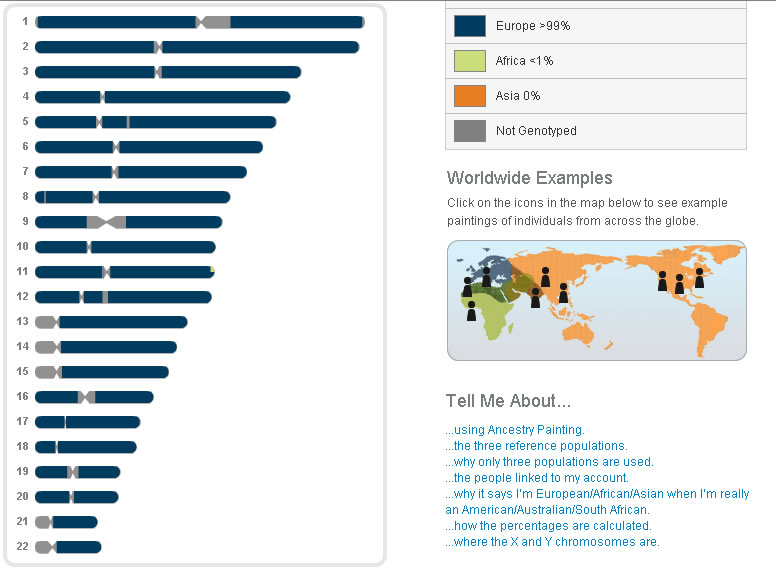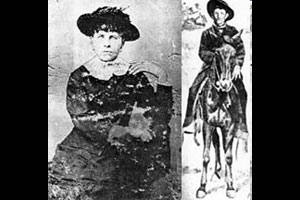This is all well and good from a survival of the species point of view, but it is a problem for ancestry testing. Imagine that instead of my mom, we look at my Cherokee great-great grandmother. She has just had a child who inherited a mix of her chromosome 1’s. This chromosome will look Native American and the child would appear half Native American.
Actually, the test isn’t perfect yet and so there isn’t yet a “Native American” set per se. Instead, here is how 23andMe describes Native American DNA in their tests:
“…people who identify themselves as Native American exhibit fairly consistent Ancestry Painting proportions of about 75% Asian and 25% European, plus or minus 10%.”
This means the chromosomes the child got from his or her mom won’t look Native American but instead will look 75% Asian and 25% European. (See a realted post of mine elsewhere for why it looks like this.) Now imagine that this half Native American child grows up and has my grandfather as his or her son.
My grandpa will inherit a mix of his parents’ DNA too. In this case the Native American DNA will mix with the European DNA to create a hybrid. On average, you would now see something along the lines of 37.5% Asian (this is a simplification but it gets us into the ballpark of the number we might expect).
Each generation would see, on average, a continued dilution of this Asian part. My dad would have 18% Asian, I would have 9%, etc. Here are my ancestry results (click the image to enlarge):

Not a hint of Asian. Looks like my great-great grandma wasn't Cherokee. Or was she?
There are lots of ways she could still be Cherokee. First off, I don’t know how solid the 75% number is for all Native Americans. I don’t know how many Native Americans are in their database. I also don’t know how much variation there will be tribe to tribe.
Secondly, you may have noticed that I was very careful to always say, “on average.” This is because the recombinations don’t have to be a 50-50 swap. It is true that if you look at a large number of recombination events, the average will be 50%. But individual recombination events can be biased towards one or more chromosomes. Occasionally you’ll get mostly one chromosome and sometimes mostly the other.
Sort of like flipping a coin—do it enough and you’ll get pretty close to half heads and half tails. But if you flip a coin twice, you might get one head and one tail. And you might not. Half the time you’ll get two heads or two tails.
This is less a problem than you might think with our chromosomes since the recombination is spread over 23 pairs with each pair being independent of the others. But it can still throw a monkey wrench into the works. 23andMe actually has a nice chart that hints at this by giving the most likely range of possibilities. Unfortunately, this chart didn’t come up with my results and I had to stumble on it while I was playing around.
Using the chart, I can see that the bottom end of my expected results in 0.24% “Native American” (if I am reading the chart correctly). That is pretty low and it seems like a pretty minor mistaken assumption at the beginning might knock this down to zero.
So where am I after this? Still in the dark. This is actually how many genetic tests end up.
The positive result tells you a lot. Had there been Native American DNA, that would have been a slam dunk. (This isn’t always the case with genetic tests but it would be here.) But there wasn’t. Which means, given that I was on the edge of detection, that she may or may not have been Cherokee.
Now, this isn’t 23andMe’s fault. The test itself couldn’t be conclusive given how far back we need to go and the DNA tests that 23andMe offers. In fact, 23andMe does an excellent job of presenting the data. There are pretty chromosome paintings, graphs superimposed on world maps, etc. All very nice.
I am still worried that the explanations that go along with these images assume an awful lot of knowledge that most people might not have. Without that knowledge, it can be hard to assess the significance of a certain result. Next blog that’ll become even more important as I tackle health conditions.
 Are they related to me? I still don't know...When last I left you, I was searching for my great-great grandmother’s DNA in my own DNA. Remember, legend has it she was Cherokee and I wanted to confirm the legend with a genetic test from a company called 23andMe.
Are they related to me? I still don't know...When last I left you, I was searching for my great-great grandmother’s DNA in my own DNA. Remember, legend has it she was Cherokee and I wanted to confirm the legend with a genetic test from a company called 23andMe.
